Stephan Welz & Co. present their November Premium Auction
21 - 24 November 2022
--------------------------
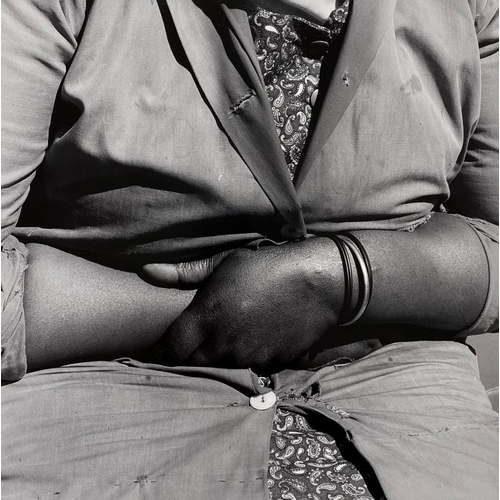
Stephan Welz & Co. is proud to present their November premium auction in Johannesburg featuring several prestigious artists. From masters such as Jacobus Hendrik Pierneef, to contemporary yet canonical artists such as Esther Mahlangu – this auction will set the tone for the festive season. Amongst this wide and impressive range, they have noteworthy pieces by Cecil Skotnes, William Kentridge, Jim Dine and Lionel Smit. However, their selection of bronze sculptures for this auction definitively represents Stephan Welz & Co’s lineage of quality art.
Be sure to view and bid on 250 works from auction house Stephan Welz & Co. here.
Public Viewing:
14 – 16 November, 10am – 4:30pm
18 & 19 November, 10am – 4:30pm
-----
Featured artists
Cecil Skotnes
Cecil Skotnes initially began his career as a painter, often painting landscapes. Skotnes aimed to move beyond the motifs captured by his predecessors like Frans Oerder, Pieter Wenning, and Hugo Naudé in their depictions of the South African landscape. Skotnes was encouraged by his friend and art collector, Egon Guenther, to pursue printmaking instead. Skotnes gave up painting and began carving a unique artistic identity in wood after Guenther gifted him a kit of wood engraving tools.
Skotnes’ earliest woodcuts were of landscapes and showed the stylistic influences of those by Rudolf Scharpf and Willi Baumeister. However, he strove to develop a visual language that was distinctly South African. During the 1960s, Skotnes expanded on the potential of the woodcut as a medium, focusing on the possibilities of the wood block functioning as an artwork in its own accord. The portfolio ‘The assassination of Shaka’ exposed his artistic skills as a woodcut authority and artist. His recognition that the woodblocks also represented sculpture works led to the production of larger incised panels. The present panel is a superior example and represents a painted version of his creative play and spatial tension. With his advanced colour management, the textured panels became important works of art in their own right. This newly adopted technique initiated his departure from landscapes, with Skotnes commencing to concentrate on expressing the human figure in art.
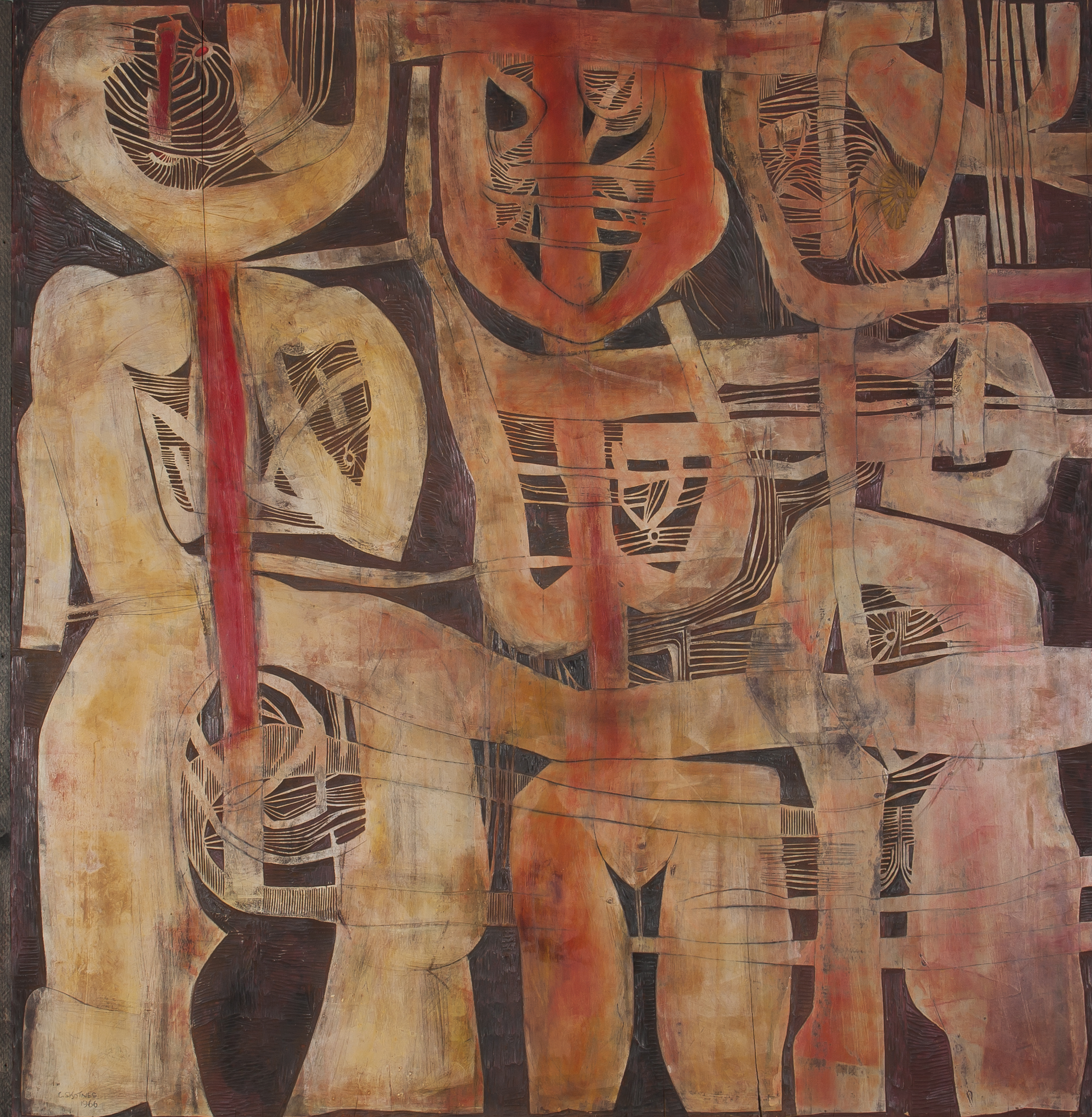
Cecil Edwin Frans Skotnes (South African 1926 - 2009) THE NARRATIVE, set of 8, Estimate: R2 500 000 – R3 000 000, Lot 932
Inspired by the works of the German expressionists, the Cubists, and his enthusiasm for African art, Skotnes' images took on anthropomorphic qualities derived from the angular forms, vibrant colours, and tonal contrasts of the African environment. Skotnes created compositions filled with highly abstracted and boldly cut figures that were underpinned with explorations regarding historical events as well as marginalized South African histories.
The palette of ochres, reds and browns used to stain the wood, create a sense of warmth and are reminiscent not only of African tribal art but also the hues of the African bushveld. It is not uncommon to encounter figures that are portrayed larger than life, thus looming over the viewer, rendering a sense of gravitas from his large panels. The ambiguity present in Skotnes’ panels compels the viewer to contemplate the complexity of the human dilemma.
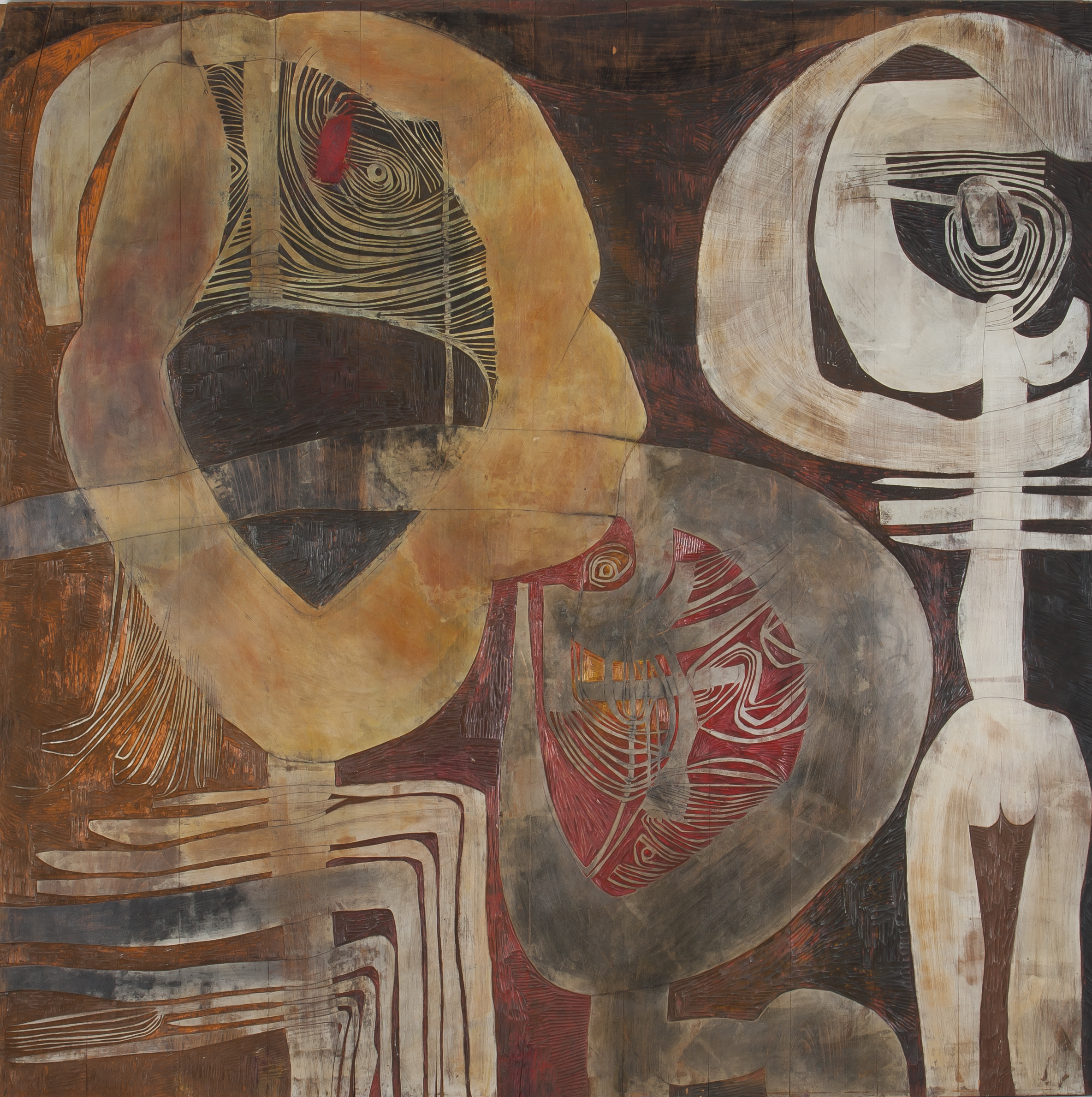
Cecil Edwin Frans Skotnes (South African 1926 - 2009) THE NARRATIVE, set of 8, Estimate: R2 500 000 – R3 000 000, Lot 932
Walter Battiss
Walter Battiss’ art can only be described as an evanescent of eccentrics – Battiss’ multiple sources of influences over the span of his career are a testimony to his artistic philosophy that art belongs to the present moment. A credo which was a direct response and rejection of the conceptual art movement.
During his formative years, Battiss had an interest in archaeology which laid the foundation for his fascination with South African rock art and San paintings which influenced his works throughout his career.
 Walter Whall Battiss (South African 1906 - 1982) FIGURES AND SYMBOLS, estimate: R12 000 – R15 000, Lot 821
Walter Whall Battiss (South African 1906 - 1982) FIGURES AND SYMBOLS, estimate: R12 000 – R15 000, Lot 821
In the 60s his art was characterized by a technique called ‘Sgrafitto’ which is defined by scratching visuals into multiple layers of oil. Battiss was also well-versed in his palette knife technique and often used these methods to add character and depth to his oils. It was during this point of his career that Battiss started to draw inspiration from artists such as Pablo Picasso, who he exhibited alongside during the 70s.
Battiss was also influenced by his various travels to America, the middle east and Greece which sparked his fascination with islands and formed the bases of his most well-known conceptual and figurative creation “Fook Island”.
Battiss is canonical to South African art history and is one of the leading artists of the 21st century. He has become a noteworthy name amongst art collectors both abroad and locally.
Sculptures on auction:
Stephan Welz & Co. is proud to present our penultimate premium auction in Johannesburg in November, featuring several prestigious artists. From masters such as Jacobus Hendrik Pierneef, to contemporary yet canonical artists such as Esther Mahlangu – this auction will set the tone for the festive season. Amongst this wide and impressive range, we have noteworthy pieces by Cecil Skotnes, William Kentridge, Jim Dine and Lionel Smit. However, our selection of bronze sculptures for this auction definitively represents Stephan Welz & Co’s lineage of quality art.
Sculptures transcend time and encapsulates the nature of artistic processes. To take the mundane and mold it into the artists interpretation or vision of these items within the world that surrounds them is to solidify perception. The non-perishable nature of sculptures exemplifies their weight and bearing on the art world and often leaves us in awe as they can immortalise an era – something which transcends human capability.
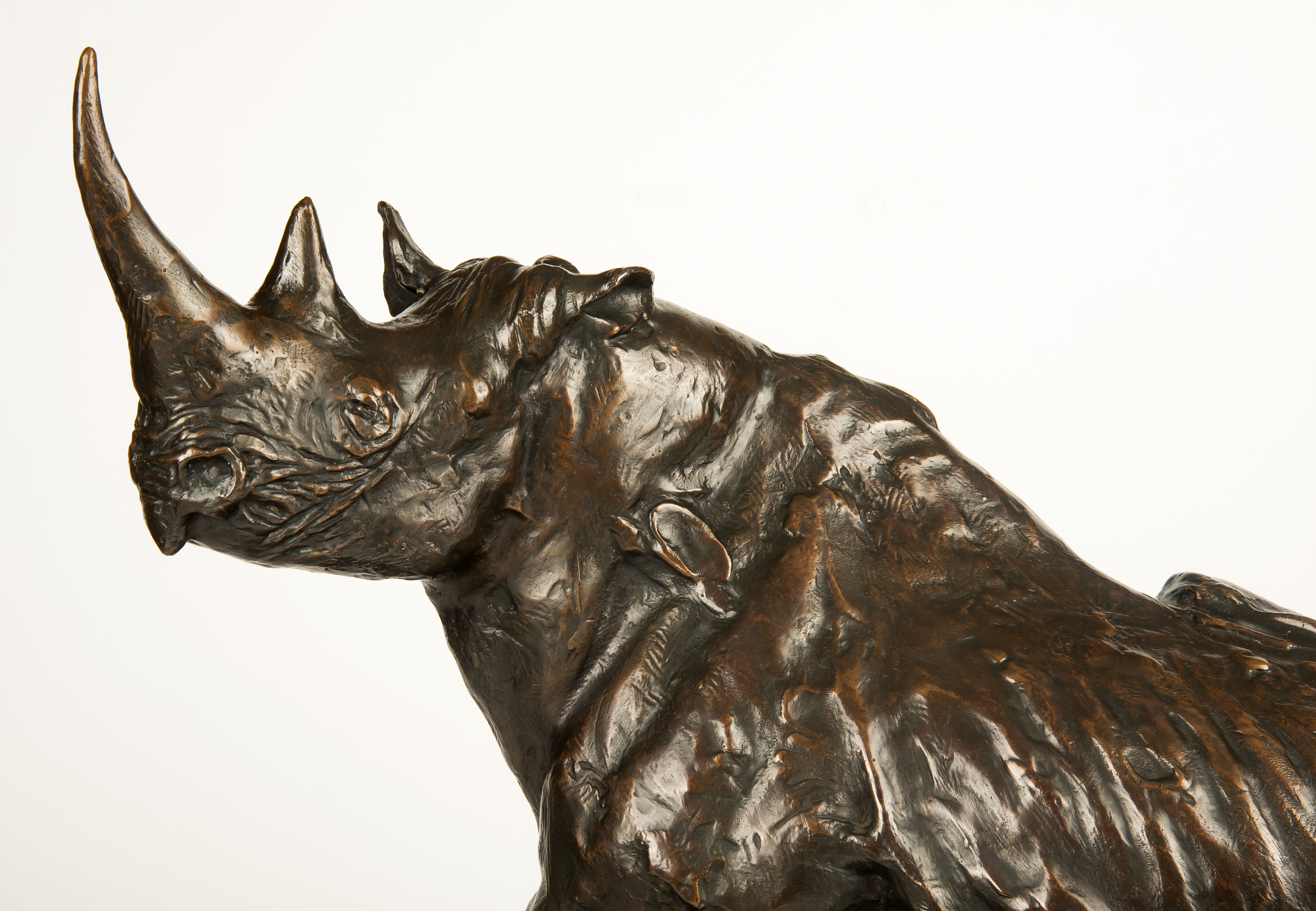 Dylan Lewis (South African 1964 - ) CENTENNIAL BLACK RHINOCEROS MAQUETTE, Estimate: R200000 - R220000, Lot 882
Dylan Lewis (South African 1964 - ) CENTENNIAL BLACK RHINOCEROS MAQUETTE, Estimate: R200000 - R220000, Lot 882
Dannie de Jager is described as a contemporary post-war South African sculptor. The onset of de Jager’s career can only be defined as a struggle for recognition. The now notorious sculptor only reached a point of popularity in the 60’s. Nowadays, de Jager’s sculptures frame the entrance of some prestigious buildings around the world and can be found in the collections of some high-profile celebrities.
De Jager’s most well-known and prestigious sculpture is Shawu, the elephant bull who formed part of the magnificent seven and was epitomised as the height of successful conservation in the Kruger National Park. Shawu had the longest recorded tusks of the magnificent seven and holds a prime spot in the Letaba Elephant Hall. The original life size bronze was initially cast in Italy and now guards the Palace of the Lost City at Sun City resort. De Jager went through an extensive research process to do the final cast of Shawu and studied not only the anatomy of the bull himself but spent a significant amount of time observing other elephants across South Africa.
The life size version of Shawu was cast using a clay de Jager made himself and it included petroleum jelly as a base which never hardens or dries completely. Using the life size version of Shawu, de Jager cast several miniaturized versions using a plaster technique which was eventually cast in bronze. The miniaturized version we are offering on our November Premium Auction has been collected by noteworthy South African political figures such as former president de Klerk and it is accompanied by an album signed by de Jager himself which details de Jager artistic and extensive research process.
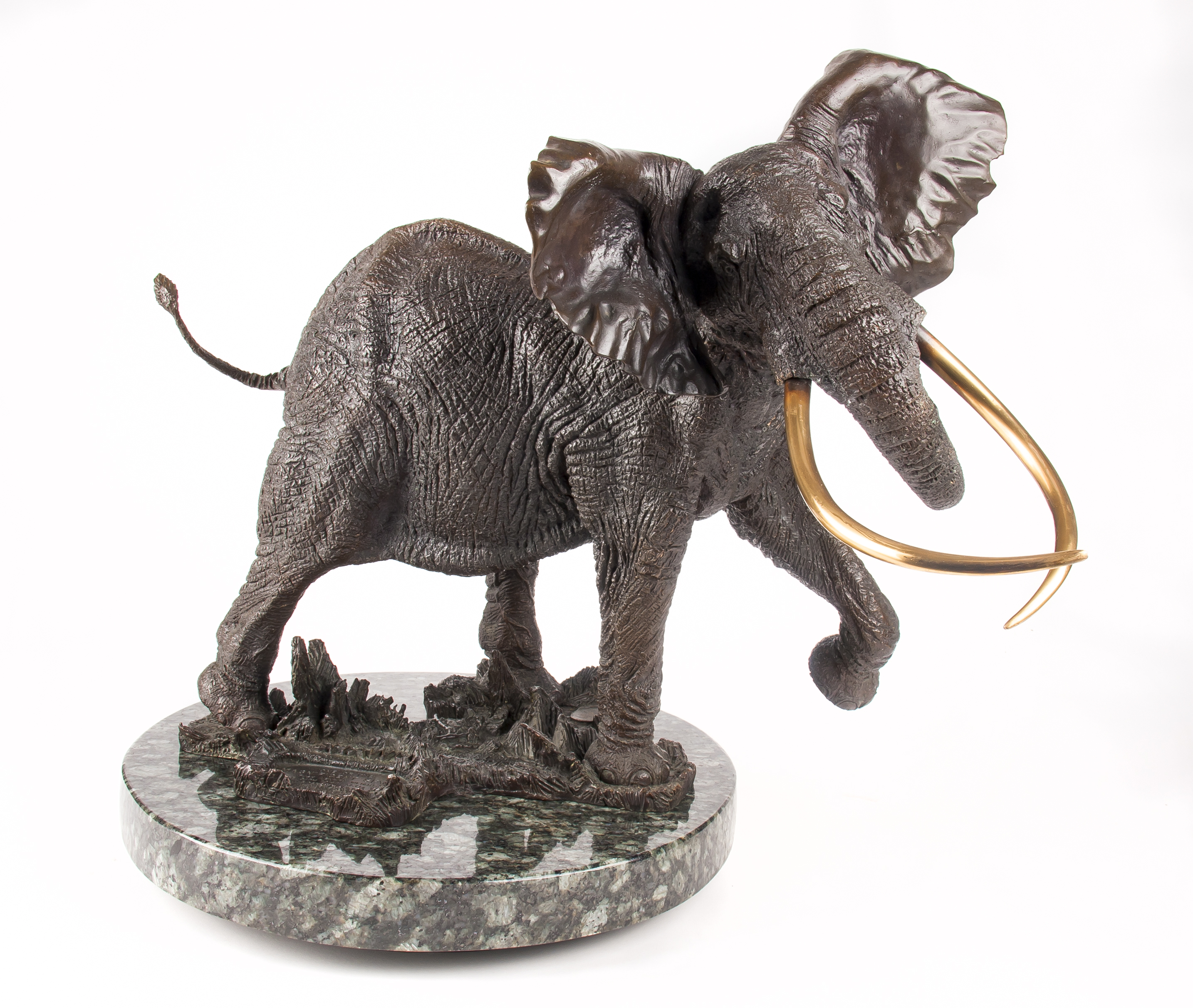
Danie de Jager (South African 1936 - 2003) SHAWU, Estimate: R100 000 – R150 000, Lot 883
Another prominent and revered sculptor we are excited to showcase is Dylan Lewis. After the tragic death of his father Lewis felt it was his calling to continue his father’s legacy as an artist. Initially, he began as a painter but later turned to sculpture as his primary medium. Lewis’s work explores the interconnectivity and holistic effects of nature on both mankind and animals. A large majority of his work speaks to the duality between humans and animals – his human subject matters always depict animalistic tendencies, and his animal forms tend to evoke a range of emotions. Lewis believes that animals such as the Rhino and the Buffalo embody notions of “birth, power and violence” (About Dylan Lewis Sa:sp). Thematically, Lewis’ work speaks to the idea of returning to a place we once came from and the formidable subconscious desire to succumb to our intrinsic animalistic tendencies which were once viewed as taboo. His art celebrates the dichotomy between birth and death, violence and peace, power, and weakness – it is these themes which govern Lewis’ body of work.
The Centenary Rhino on offer is a miniature version of the life-size sculpture which stands outside the Centenary Game Capture Centre in Hluhluwe Imfolozi game reserve. The sculpture was commissioned by the Natal Parks Board to celebrate 100 years of conservation and catapulted Lewis’ career as a sculptor. The first miniaturized version of the Centenary Rhino was first gifted to Nelson Mandela when he was an honoured guest at the Hluhluwe Imfolozi game reserve.
Accompanying these works is Tienie Pritchard’s Pandora. Throughout his career Pritchard explored the human form, especially the nude or semi-nude female form. He is considered one of South Africa’s foremost sculptors of the nude human form despite his struggle to recognition. Initially, Pritchard’s nude sculptures were considered detrimental to social morality and were criticised for being inappropriate to display publicly as they deviated from the themes and subject matter of his predecessors, the Volksbeeldhouers, which included the likes of Anton van Wouw. This controversial overtone his works were branded with lasted throughout most of his career.
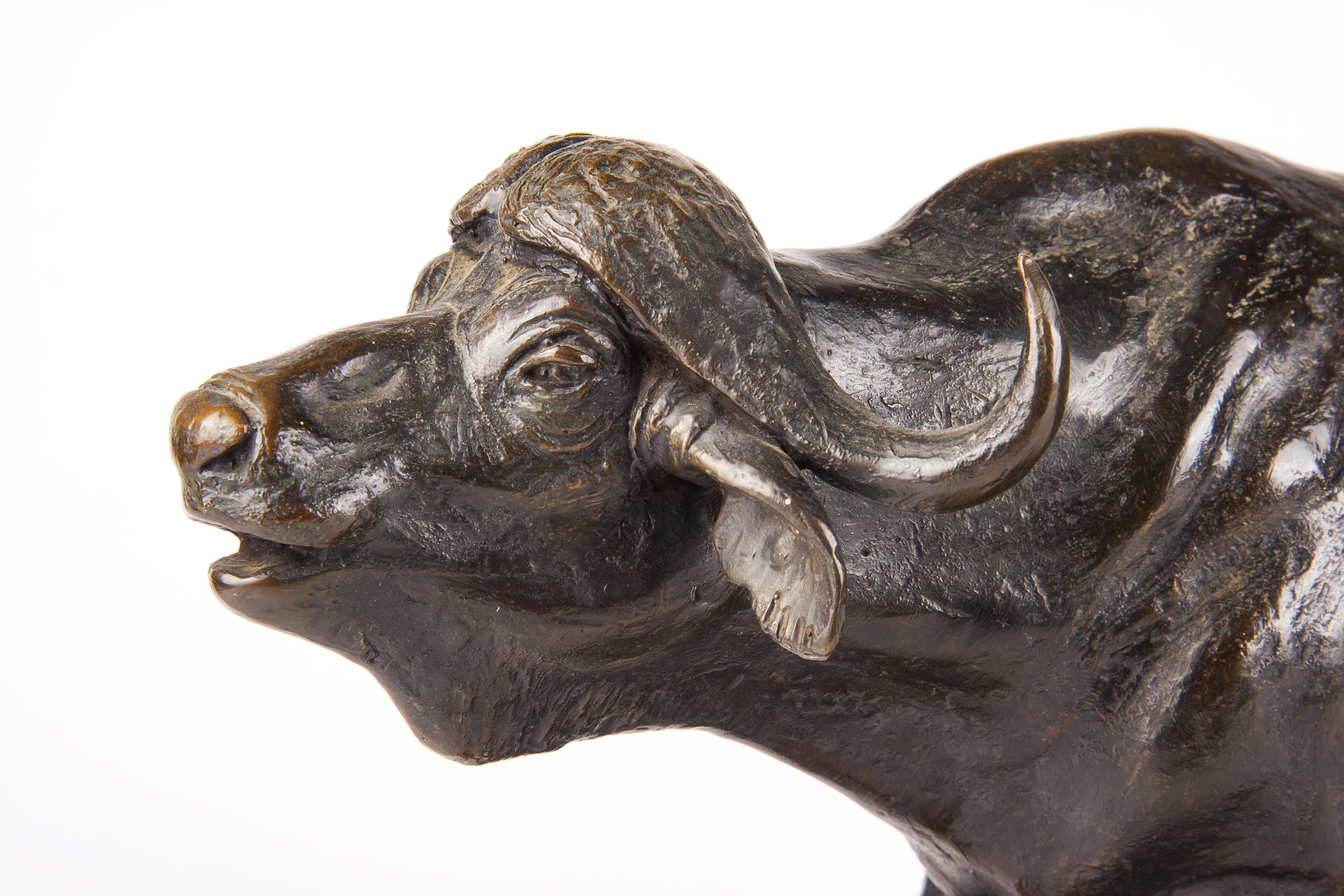
Arend Eloff (South African 1964 - ) BUFFALOES, Estimate: R15 000 – R20 000, Lot 884
Pritchard believed that the human body was able to express a vast range of concepts when it is turned into art (Pritchard 2013: 14). While his earlier nudes were and rich in symbolism, they lacked cultural identity. As Pritchard furthered his creative explorations, he wished to portray more than just the human emotion and anatomy in his pieces and turned towards portraying man beyond the tangible world. This sparked an interest in ancient civilizations and the mythological nature of these cultures. He was able to represent a range of mythic subjects in his sculptures, often representing the female nude as priestess, sorceress, goddess.
Pritchard’s sculptures stylistically exemplify small-scale Renaissance and 19th Century bronze figural sculptural cannons and traditions. This was characterized by skilled and refined surface modelling, fine details and a rich patina. Many of his sculptures were modelled from live subjects as he believed working from them imbued a soul into the sculpture that would not be present otherwise. Oftentimes, Pritchard placed the human body in unexpected compositions and daring poses. An apt example of this characteristic is seen in Pandora’s Box. Pritchard has depicted the Greek mythological figure Pandora in a moment of struggle as she attempts to close the box that is spewing sorrow, disease, vice, violence, greed, madness, old age, and death. Pandora’s desperation and shock is captured in her face as she gasps and places her whole body and weight on top of the lid to keep the box closed. Pritchard has materialised concepts of “human miseries” by sculpting them as dragons, snakes, skulls, and monsters escaping the box.
Following Pritchard, yet another noteworthy artist on offer is that of Edoardo Villa. Villa’s work largely speaks to a conceptual exploration of form, line, mass, and volume. His sculptors often characteristically take on a geometrically abstract aesthetic although this has not always been indicative of his work. Villa’s earlier artworks differ greatly to the abstract forms and structures we see today. However, his early pieces lend a hand in the formation of his later pieces and ties into the ongoing conceptualization of continuation.

Edoardo Villa (South African 1915 - 2011) STANDING FORM, Estimate: R25000 - R35000, Lot 861
Villa’s work perpetuates a paradoxical discourse between form and content. The form of his structures often determines the recognizable characteristics one would find in his sculptures or in other words the content of his sculptures. Villa’s work is an examination of growth and ever evolving form which evokes a contradictory relationship of constricted movement – giving his work a feel of autonomy.
During the 70’s Villa was inspired by the industrialization that was taking hold of South Africa which led him to the use of steel in his sculptures. He felt that it was not only indicative of the era of South Africa, but it also spoke to the formation of the rising urban black population. The South African art scene has celebrated Villa’s works for many years, and he is a necessary and canonical element of African art history.
Kentridge & Dine:
In William Kentridge’s artwork The Black Iris and Jim Dine’s Desire in Primary Colours both artists are exploring the processes of printmaking. Each piece represents a step in the numerous layering process that is indicative of prints. Although Kentridge is well versed in an array of mediums, his Iris series has become synonymous with his artistic iconography. He initially started the Iris series as an experimentation with pigmentation, hence the alluring dark purple hues seen in the Black Iris. Usually, Kentridge’s work is thematically concerned with the socio-political context of post-apartheid South Africa however, the Iris series differs as it concerns itself more with Kentridge’s artistic process. This series perfectly represents Kentridge’s stylistic currents towards expressionism. The identifiable disciplined line deformations in this work alludes to a sense of catharsis.

William Joseph Kentridge (South African 1955 - ) BLACK IRIS, Estimate: R800 000 – R1 200 000, Lot 904
Similarly, Dine is also easily identifiable through his staple iconography of hearts, robes, and trees which are also stylistically tinged with an expressionist technique. Dine uses these mundane objects encountered in his everyday life as an autobiographical representation of his lived experience, and his work has been likened to a sense of stream of consciousness. He was born into a tool-making family and has been enchanted by their subtle presences in his life ever since his childhood. Dine is an important American artist who has greatly contributed to the establishment of artistic era’s such as Pop art, abstract expressionism, and Neo-Dadaism although he never formally recognized himself as being part of these art movements. His works have been showcased with the likes of Andy Warhol and Roy Lichenstein.
These parallels are remarkable to note given the dissimilarity of Dine and Kentridge’s backgrounds and the distinctiveness in their conceptual and individual artistic approach. Yet there is an undeniable stylistic familiarity conspicuous amongst both artists’s graphic prints.
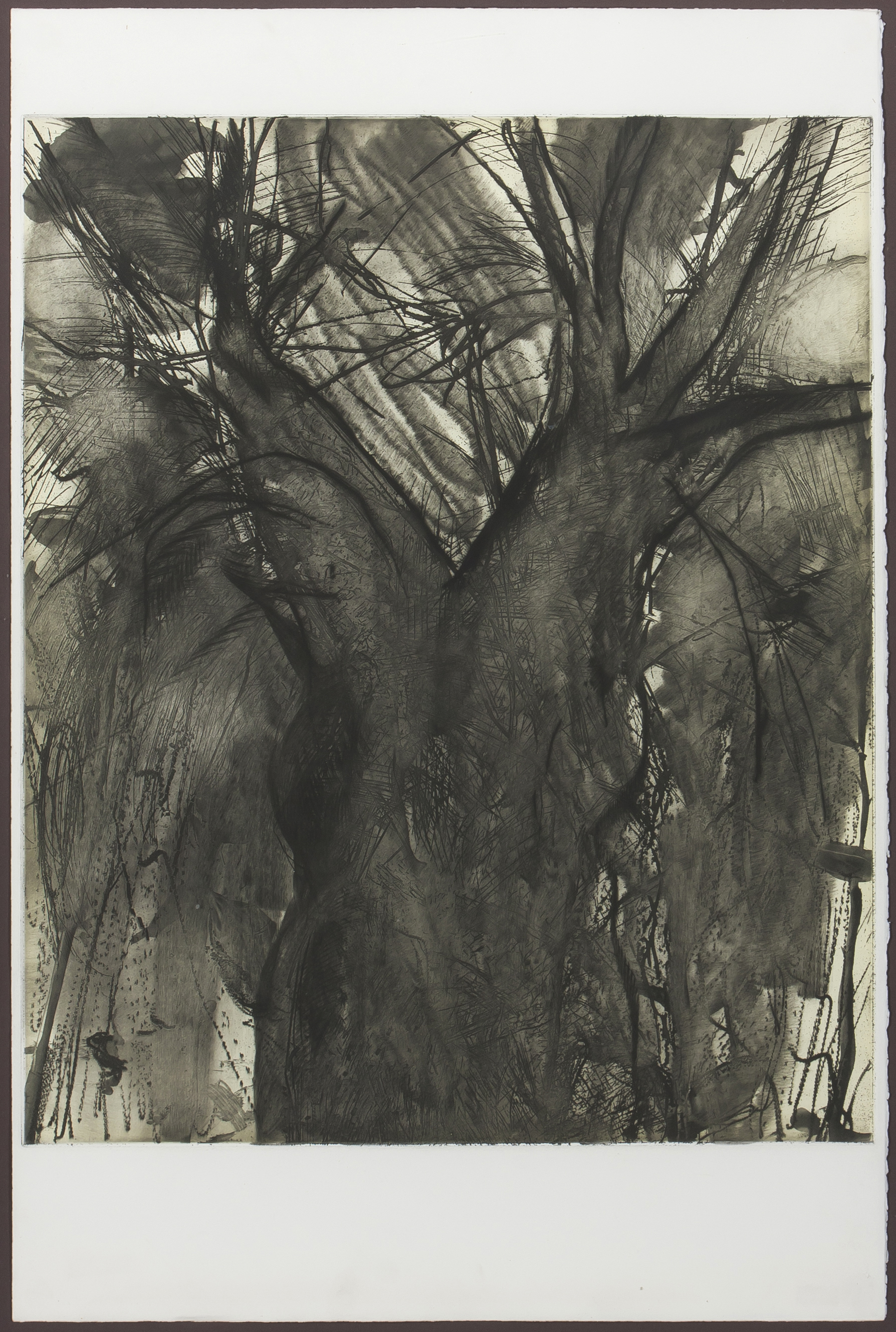
Jim Dine (American 1935 - ) DESIRE IN PRIMARY COLORS, triptych, Estimate: R60 000 – R120 000, Lot 905
-----------------
View the full catalogue here.
To view the available lots, register or bid, visit www.swelco.co.za. For condition reports or any queries, contact us on 0118803125 or info@swelco.co.za
Session Plan
Monday 21 November 2022
Session 1 | 10am
Books 1 – 41
Carpets 50 - 76
Session 2 | 2pm
Silver 80 – 204
Session 3 | 7pm
Wine 210 - 267
Tuesday 22 November 2022
Session 4 | 10am
Collectors 269 – 300
Coins 310 - 347
Cars 350 - 351
Military 352
Session 5 | 2pm
Asian + Decorative Arts 360 - 453
Session 6 | 7pm
Clocks 460 - 467
Watches 475 - 487
Vintage Fashion 495 - 510
Furniture 520 - 580
Wednesday 23 November 2022
Session 7 | 10am
Fine Art 600 - 732
Session 8 | 2pm
Furniture 740 - 800
Session 9 | 7pm
Fine Art 820 - 936
Thursday 24 November 2022
Session 10 | 10am
Jewellery 940 - 1093
Gemstones 1100 - 1136
Further Reading In Articles
African Artist Directory















